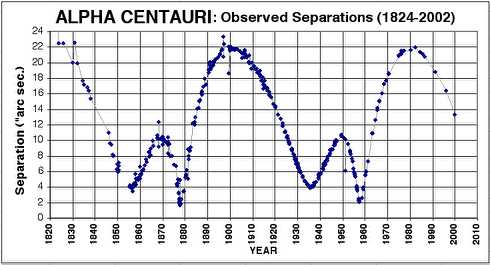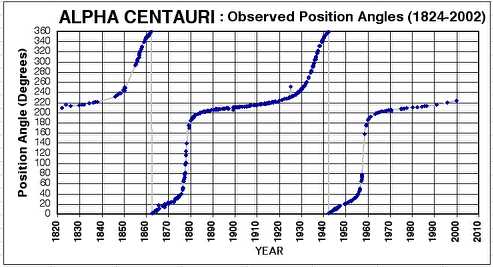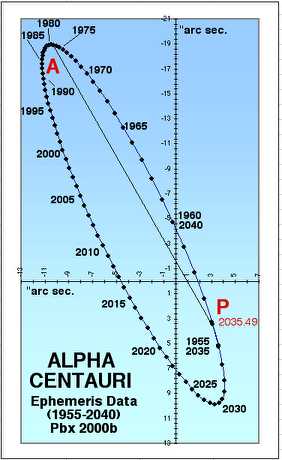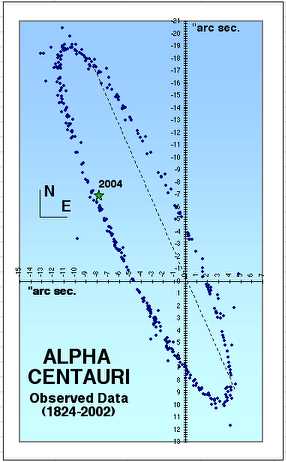



Based on these rough estimates, this can be seen graphically in Figure xx., showing separation versus time.



|

|
*******************************************
Finsen Heinze Pourbaix
(1926) (1955) (2002a)
*******************************************
T 1875.789 1955.56 1875.663
P 80.089 79.92 79.914
a 17.665 17.515 17.575
e 0.521 0.516 0.5179
i 79.223 79.240 79.205
Ω 205.443 204.87 204.849
ω 232.132 231.56 231.651
Grade ? 1 2
*******************************************
*************************
Thiele-Innes Constants
Heinze Pourbaix
(1955) (2002a)
*************************
A : 8.8020 8.8100
B : 6.9032 6.9249
C : -13.4776 -13.5392
F : -13.3015 -13.3653
H : -10.6975 -10.7114
*************************
The older orbital elements were produced by W.D. Heintz and were used in the 3rd, 4th and 5th ‘Catalogues of Orbits of Visual Binary Stars’. These values are considered to be accurate between the years 1950 to 2000. In the US Naval Observatory (USNO) ‘Sixth Catalog of Orbits of Visual Binary Stars: Orbital Elements’, these are referenced as Hei1958, but the final element were actually published in Veroff. Sternw. Munchen., 5, 100 (1960). The next orbital elements with a higher precision were added to the 6th Orbit Catalogue. These appeared in a 2002 paper published in Astronomy and Astrophysics by a collaboration, whose first name is listed as the Belgian observer D. Pourbaix. These observers were able to measure and reevaluated the blueshift between the two components then compared them to quailty radial velocities.”, This is abbreviated in the WDS Reference file as Pbx2000b. One of the main differences is the quality grade of the orbit, which is downgraded to 2.
************************************* Perihelion | Aphelion ************************************* Hei1958 Pbx02000b Hei1958 Pbx2000b ************************************* 1797.08 1795.749 1836.70 1835.706 1876.32 1875.663 1915.94 1915.620 1955.56 1955.577 1995.18 1995.534 2034.80 2035.491 2074.42 2075.448 2114.04 2115.405 *************************************
In 2004, this binary is easily separated - even in a small telescope. Any 5cm telescope can probably resolve it 50% of the time, though combination of the brightness of the pair and poor seeing, sometimes make this difficult. I have seen it resolved with a pair of 7x50 binoculars, but it had to be firmly fixed to a tripod. The minimum aperture for resolution is presently (1999) between 4cm and 4.5cm. On good nights, my small 5cm refractor has little trouble with powers greater than about 25x magnification. In the city some six stars occupy a 0.25o field and this increasing to about ten in darker country skies. I find that both stars can easily be found during daylight and separated cleanly in apertures above about 7.5cm or more. In daylight the colours lose their yellowness, appearing like brilliant white “diamonds” against the blue sky. Due to the overwhelming sky, I had some trouble separating the pair with the 5cm refractor. This is reverse to my understanding of optical and double star theory as this should become easier as the images cannot “blur” together so easily. Three attempts by me have been made - none successful. (Maybe I was just unlucky!) To find Alpha Centauri in daylight, an equatorial telescope is a distinct advantage, as the position can be simply dialled up using the setting circles.
In the decades to come the decreasing separation will make resolution far more difficult. Observers may tend to make calculations on telescopic resolution using Dawes Limit where visual separation is stated as 11.58″/ Aperture (cm) or 4.54″/ A (inch) Frankly applying this is useless, as the brightness of the two stars overwhelms true separation. Problems with this will apply to α Centauri just after 2010, and between the years 2023 and 2031. The minimum aperture to separate the pair when 10″arcsec. apart will be 11.5cm telescope.
As separations reduce below 5″arcsec, this will become even more difficult, due to the problems with the seeing and so-called proximity. A good comparative test of this particular problem is the other “pointer” - Hadar / Agena (β Centauri). (See below) The value in the Dawes”s equation this instance should be set to about 13.5″ / A(cm). Around 2013 to 2017, and the years 2035 and 2039, the minimum size telescope required will be a 20cm but a 25cm will have no difficulties. A neutral density filter may have to be used to cleanly separate the two stars during periods of poor seeing. November 2037 is the closest approach in the orbit where separation decreases to a meagre 1.71″arc sec on the eastern or preceding side. (PA of 12o) Changes in Position Angle for five or six months reaches 5o each month. For a few years, depending on the seeing conditions, the pair will be very hard to resolve. It is best to use a hexagonal diaphragm - a hexagonal shaped cover placed over the mirror or lens, or by using a neutral density filter. Estimating the constant used in the Dawes equation will likely be between 14″/A (cm). and 15″/A (cm).
At minimum separation, H.C.Russell did measured the pair on the 18th February 1878; was 1.66″, but he was using a sizeable refractor! A 25cm may be able to glimpse the duplicity, and 30cm and above will have no real problems! It is fortunate for the observer that within two years this difficult period of observation will soon pass.
Alpha Centauri”s also has a rapid common proper motion producing a close approach or stellar conjunction with Centauri in 6200AD. The minimum distance reaches 23′arcmin or 1380″arc sec.
This will be the best stellar conjunction for 1st magnitude stars for the next 400 000 years, and becoming truely the best double star in the sky!
1. My fellow Australians, however, seem to have forgotten this reverence, as it is the only star of the “Cross and the Pointers” left off the Australian Flag!
2. He must have been a modest man in my opinion judging by his particular elegant literary style.
3. Interestingly, it is the same page as the announcement and image of the proto-plaetary disk surrounding Beta Pictoris and the likely formation of a planetary system. It was discovered by the IRAS satellite in January 1984.